Iroquois China Company
 | |
| China and Pottery Manufacturing | |
| Industry | Pottery |
| Genre | Restaurant dinnerware |
| Founded | 1905 |
| Founder | J. Brewster Gere and Lemont Stillwell |
| Defunct | 1969 |
| Headquarters | Syracuse, New York, United States |
Area served | United States |
| Products | Vitreous China tableware |
Iroquois China Company was founded in 1905 in Solvay, New York, located on the western border of Syracuse near the southern shores of Onondaga Lake. It operated in Syracuse until closing. Although some references indicate that the company closed in 1969, certain designs (e.g., "Informal", "Museum White") were advertised and sold until the early-mid 1970s.
History
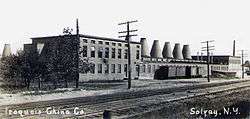
Iroquois China Company was founded in July 1905, by J. Brewster Gere of Syracuse and Lemont Stillwell of Solvay. The company was established after a failed pottery enterprise, Syracuse China Company, went bankrupt and both the plant and equipment were offered for sale in the bankruptcy proceedings.[1]
Gere and Stillwell decided to purchase the plant because it was offered for $27,000, a fraction of the $90,000 that Syracuse China Company paid for construction of the building. Papers of incorporation with capital of $75,000 were sent to Albany, New York, the capital of New York State in July 1905.[1]
At that time, six carpenters were employed by the pottery. They built pottery benches and fastened the machinery and readied the plant for opening day. Three kilns were operational and it was decided that the completion of another three kilns would be withheld until the company showed profits.[1]
Richard Sweeting was the first superintendent and made the decision to begin production before September 1, 1905.[1]
Solvay plant
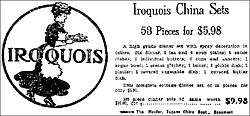
Construction of the factory was first mentioned in local newspapers in June 1904. At that time, an enterprise named Syracuse China Company announced they were building a new plant in Solvay, New York. The contractors for masonry work, O'Connor Bros., began excavation for the foundation walls by July 1904.[2]

Local architect, Charles E. Colton designed the plant. The factory had a capacity of 600 employees. The initial plan was the first three kilns would be placed in operation and on opening day, the company would have a workforce of about 75 men. The management also planned that it would take six months for the plant to reach full capacity. The building was constructed at a cost of $90,000 which along with equipment represented an investment of $125,000.[3]
In January 1905, the factory was ready for production to begin and plans set in place, however, financial problems arose. A petition in involuntary bankruptcy was filed in Utica, New York, against the Syracuse China Company by Thomson, Woods & Smith, representing Stowe-Fuller Company of Cleveland, Ohio.[4]

A representative of the Syracuse China Company said that the petition would not delay the beginning of operations, however, the Syracuse China Company went bankrupt and Iroquois China Company was formed shortly after.[4]
By late 1905, the company began producing classic Victorian fine china with decorations such as pink roses and green leaves with "slightly scalloped edges." Along with tableware, the firm marketed pieces such as cheese and butter dishes.[5]
Board of directors
The men who constituted the first board of directors in 1905 were;[1]
- James Kerr of Clearfield, Pennsylvania
- Albert B. Kerr of New York City
- C. B. Corey of Syracuse
- J. Brewster Gere of Syracuse
- Lemont Stillwell of Solvay
Iroquois growth
The business was reorganized in 1913. Walter H. Kerr was president and general manager. The Solvay plant resided on two acres of land and there were 200 employees. The factory produced more than 3,000,000 pieces of china annually and the china was sent to "every state in the union and to part of the island possessions of the United States."[6]
During 1913, the company was operating at full capacity and was getting ready to purchase additional land to expand in order to double their output.[6]
By 1930, the company output was 4,500,000 pieces and the ware was sold in "every state in the Union and also in all our foreign possessions." The United States government ordered over 500,000 pieces after testing the china in a competition with other makes.[7] The company had been doing business with The Syracuse Trust Company on 330 South Warren Street who gave a recommendation for Iroquois China Company in the local newspaper;
"Syracuse needs such industries as this. Every thoroughly good product that goes out from our city brings back returns in new business and new enterprise. New business is what Syracuse Trust Company wants. We are equipped and able to assist you in handling the financial end of your plant."[7]
Restaurant ware

During the early years of china production, Iroquois focused on commercial ware. Some of their famous customers were the Waldorf-Astoria in New York City, the Blackstone in Chicago and the Brown Palace Hotel in Denver. The company also furnished china to all the Pullman dining cars and many other large railroad and steamship lines. It was also in use by the U.S. Army and U.S. Navy and various branches of the government including all the china required by the government for the Panama Canal Zone construction project.[6]
Iroquois manufactured plates for diner cars and would top stamp them with the diner's individual name such as the Sterling Diner which was produced from the 1930s through the 1940s. The pattern, named Pendleton, was a classic design with three-stripes consisting of red, green and yellow that ran around the edge of each piece.[8] This same pattern was produced by McNicol and Buffalo China and called Rainbow Cafe.[9]
A subsidiary of the company was named Iroquois Restaurant China and produced patterns such as Chatham.[10]
Dinnerware lines
The company made only commercial china until 1946 when their first dinnerware lines were introduced. The dinnerware was made out of vitreous china, similar to their commercial ware, but in very modern shapes.
During 1949, the Crane China Company was established in Puerto Rico.[11] The company back stamped its dishes Iroquois China. After some problems, the Sterling China Company bought the company and changed the name to Caribe China Company and later back stamped their product Caribe China, Puerto Rico, USA.[12]
Iroquois Red, designed by W. S. George, had a red band with diamonds around the edge. The set was discontinued in 1948.[13]
Beginning in the late 1940s, Iroquois developed a keen appreciation for organic materials and simple lines with freeform and abstract shapes. "A brand new mix-and-match philosophy replaced the prevailing practice of setting a table with identical place settings of formal china."[14]
Russel Wright designs

Industrial engineer, Russel Wright (1904–1976), created a line of ware for Iroquois China Company called Casual that was considered "Mid-Century Modern" in style and had a Round coupe shape. It was produced between 1947 and 1967[15] in an assortment of solid colors. The set had over forty pieces. Individual names of patterns included Nasturtium, a leafy, summery design. An unusual speckle glaze was used on one pattern which was named Raindrop. The design contained colorations that looked like water condensation.[16] Wright incorporated practical mid-century ideas like "stackable" creamers and sugar bowls in colors of "ice blue and pink sherbet" as well as unique serving pieces such as samovars for sauces and gravies. The chosen Wright colors for the Casual line included cantaloupe, ice blue, pink sherbet, seafoam blue, brick red, sugar white, lemon yellow, avocado yellow, ripe apricot, charcoal, lettuce green, forest green, parsley green and chartreuse yellowgreen.[17]
The Casual line came with matching cookware such as Dutch ovens, covered skillets, saucepans and fry pans that were oven proof and complemented the tableware. Iroquois also provided asbestos pads to protect countertops and tabletops while using the ware which were back stamped with the verbiage; "for best results use an asbestos pad."[18] Additionally, various serving pieces were produced to match the dinnerware such as vegetable bowls, "Lazy Susan" side dishes, and gravy boats and under plates.[18]
Another collectible Russel Wright style was named Interplay manufactured between 1952 and 1957. Some of the patterns were Golden Melon, Arabesque and Fleur De Lis. Most of the line was produced in white with decal treatments, however some solid colors exist.[13] A 1952 advertisement describes Interplay as "translucent fine china so rugged... so downright tough... it shrugs almost any kind of abuse. And here, for all it's suave beauty is a china you can cook in... roast, bake, or broil... serve in a step from oven to table."[19]
A contemporary design called Carrara with pattern Carrara Modern was produced during the years 1954 to 1957. The plates were white with a charcoal gray "vein" decoration in a rounded "free form" shape. The line also came in contrasting colors of dark gray with a white vein decoration. The vein decoration has been described as "giving the appearance of bad crazing."[19] An advertisement from the mid-1950s described the china as;
"From the kilns of Iroquois comes Carrara Modern, an exciting new kind of fine china! Here is a collection which combines, for the first time, the look, the feel, the translucence of fine china with the rugged durability, the cook, bake and serve qualities for which Iroquois has been famous for half a century. And it does it at a price so unbelievably low you'll be truly amazed! See it now, see its exquisitely modeled forms, see the graceful, delicate traceries of its pattern. See how rich, elegant, how luxurious it looks in traditional or contemporary settings. When you see it you'll want it for life! Sixteen piece starter set service for four, only $14.95 (charcoal on pure white). Also available in Gold on White or White Enamel on Charcoal at $16.95 per starter set.[19]
There was some debate whether Wright actually designed the Interplay or Carrara line. Most dinnerware from the 1950s was designed by Seibel, Wright and Zeisel. Both the Carrara and Interplay lacked designer names and some collectors were divided on whether they were the work of Ben Seibel or possibly a joint effort between Seibel and Wright.[19] The New York Times confirmed in a story on Modern china on September 6, 1952 that both lines were designed by Russel Wright.[20]
Wright was best known for designing American Modern for Steubenville Pottery which is considered the top selling dinnerware line of all time. He was one of the first designers to target the mass market and his trademarked signature was the first to be identified with "lifestyle-marketed products", a new concept in china sales.[14]
Wright, known as a "domestic" efficiency expert, designed his dinnerware for four companies: Iroquois China Company, Harker China Company, Steubenville Pottery and Justin Tharaud and Sons. He also produced pottery under his own label, American Way.[21]
In addition to famous china, Wright also designed furniture, textiles, tabletop accessories and barware.[14]
Ben Seibel designs
During the 1950s, Iroquois introduced a line called Informal by industrial designer Ben Seibel that had a round shape with "a stretched look." Each piece was decorated in either a two-tone white with solid color (with or without design decals) or in plain white with decals. The set consisted of approximately 25 pieces and included patterns such as Blue Diamonds, Sleepy Hollow, Steller, Teuton, Tiara, Rosemary, Lazy Daisy, Harvest Time, Old Orchard and Bombay-Green.[13] The colors in the collection were earthy and bright and included mustard, apricot, avocado yellow, blue, bean brown, nutmeg, cantaloupe, charcoal, dark-green, lemon, lettuce green, oyster, pink, red, turquoise and white. The ware was "flameproof for cooking," a new concept in dinnerware.[22] A pattern from the Informal line called Blue Vineyard was produced between 1969 and 1973.[23]
Seibel also designed a line called Impromptu[18] the first designs were Bridal White, Frolic, Vision, Jardinieres, Pins and Beads, Were Current in 1956, New Geometric Patterns like, Parasols and Pyramids. Other abstract patterns included Aztec, Fjord, Tiara, Pompon, Tiara, Pompon Garland and El Camino. Later other patterns such as were added: Grapes, Pyramids,Beige Rose'. A sleek contemporary shape called Bridal White was part of the Impromptu line and was produced in Seibel's name from 1956 to 1970.[24]
Another unique Seibel design was a line called "Intaglio", and the all white version was called Diamond White which was solid white with a sculpted diamond design around the base of each piece. Iro-Tan Ripple ware also incorporated the use of sculpting in the design using a ripple effect that wrapped the body of each piece.[13]
The Inheritance line had patterns such as Baroque, Beige Rose (Rim), Cotillion, Dynasty, Grecian Gold, Medallion, Sheer White, Sheer White-Gold, Sheer White-Platinum, and Su-Suhi . The shape was active in 1959.[13]
Seibel designed dozens of patterns for several different companies which were received with mixed reviews, however, the Impromptu, Informal and Inheritance lines he designed for Iroquois proved to be some of the most collectible sets from that period. Another popular set was called Raymor Modern and was designed by Seibel for the ailing Roseville Pottery Company. It was a bold and unusual pattern described as "a man's dinnerware."[18]
Michael Lax designs
Designer Michael Lax added the Dining +(Dining Plus +) line to the Iroquois collection in glossy white. The Iroquois Primaries line was also designed by Lax and was introduced in 1968. Both designs had minimalist quality and employed cubic shapes. Lax incorporated unique pieces such as beverage servers that had a spigot with on/off valve located on the bottom of the piece. The beverage server, which held enough drink to fill 24 cups, came with a separate base that held a small warming candle and could be purchased in either white or black.[18]
Peter Max designs

One of the most famous sets manufactured by Iroquois China Company was a vintage Peter Max design with a "mod" floral pattern which not only included dinnerware, but pieces such as collectible ashtrays. Patterns included in this Series were: Butterfly, Clover, Dove, Love and one other important Max design was called 'Opticon. It had a multicolor geometric decal decoration.
Despite the company's move to contemporary, ulitarian, modern styles during the 1950s, Iroquois China Company continued to produce Victorian style floral favorites such as Chardon Rose and Morning Glory.[24]
Later years
Toward the end of their production life, the company manufactured a line called Museum White, sometimes referred to as Henry Ford Museum, between the years 1967 and 1975. It was produced in a creamy white and had a square edged colonial styled shape. Additionally, many formal patterns such as Clinton Inn, Greenfield Village and Periwinkle were produced in the Museum line.[24]
During 1970, Iroquois China Company took a bold step and partnered with local grocers like P & C to offer a line called Joshua Crabtree, Esq. which was marketed as "Commemorative China by Iroquois from the Dansico Collection."[25]
"Now! A Supermarket First! Locally Produced... Iroquois China puts a rich American heritage on your table. The graceful designs for Joshua Crabtree, Esq., Commemorative China, were first born in America some 200 years ago. Now they have been re-created for you by the Iroquois China Company, makers of many designs in famous true china. And because they are so lovely, they have been made part of The Dansico Collection. Yet, lovely as this china is, you can cook, bake, and then serve with it! And dishwashers and detergents can't harm it.
Best of all, you can collect your set of these delightful reproductions of early Americans in easy, budget-pampering stages. Or as quickly as you like. The price list and schedule show just how easy it is. Made in the U.S.A. BY AMERICAN CRAFTSMEN."[25]
The program allowed shoppers to purchase various pieces of the set over a period of fifteen weeks. The plan offered both dinnerware and "matching accessory pieces" such as coffee pot, oval platter, covered casserole, gravy boat, butter dish, soup plate, salad plate and salt and pepper shakers. There were conditions in the program that would allow the shopper to pay thirty-nine cents "for each starter piece with every $3.00 purchase." Additionally, each week, a different piece was "featured" such as dinner plates in first week and saucer in fifth week.[25]
Back stamps
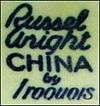 Iroquois China Company back stamp - Russel Wright - Syracuse, New York - c.1950 |
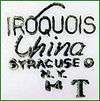 Iroquois China Company back stamp - Syracuse, New York - c.1955 |
 Iroquois China Company back stamp Interplay by Russell Wright - Syracuse, New York - c.1955 |
 Iroquois China Company back stamp Carrara Modern White - Syracuse, New York - c.1955 |
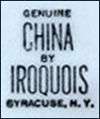 Iroquois China Company back stamp - Syracuse, New York - c.1965 |
 Iroquois China Company back stamp - Informal designed by Ben Seibel and manufactured between 1969 and 1973 - "Informal / True China / Iroquois / Ben Seibel Design / Flameproof for Cooking / Made in USA." |
Advertisements
 Iroquois China Company business customer of the Syracuse Trust Company - Syracuse Post-Standard, 1919 |
References
- 1 2 3 4 5 "To Make China in September". The Post-Standard. Syracuse, New York. July 7, 1905.
- ↑ "Excavating for China Plant". The Post-Standard. Syracuse, New York. June 18, 1904.
- ↑ "New plant of Syracuse China Company in Solvay, New York". The Post-Standard. Syracuse, New York. November 5, 1904.
- 1 2 "Say New Firm is Insolvent". The Post-Standard. Syracuse, New York. January 14, 1905.
- ↑ "Antique Iroquois China Co. Syracuse Cheese Butter Dish". Ebay Inc., 2010. Retrieved 2010-08-27.
- 1 2 3 "Iroquois China Is Being Used In All States". The Post-Standard. Syracuse, New York. January 1, 1915.
- 1 2 "Iroquois China Company". The Post-Standard. Syracuse, New York. 1919.
- ↑ "Iroquois China Rainbow Cafe". WorthPoint Corporation, 2009. Retrieved 2010-08-26.
- ↑ "Iroquois China Pendleton". Ebay Inc., 2010. Retrieved 2010-08-27.
- ↑ "Campbell's Chatham". Burwood Hall Antiques, 2010. Retrieved 2010-08-27.
- ↑ "Caribe China". MODish.net, 2010. Retrieved 2010-08-27.
- ↑ "Restaurantware". Hyacinth House, 2010. Retrieved 2010-08-27.
- 1 2 3 4 5 "Iroquois China Patterns". TheFind, 2010. Retrieved 2010-08-27.
- 1 2 3 "Dinnerware". Cincinnati Magazine Home & Garden, 2010. Retrieved 2010-08-27.
- ↑ "Iroquois China Company - Dinnerware". Hill House Wares, 2010. Retrieved 2010-08-27.
- ↑ "Casual China". Ohio River Pottery, 2007. Retrieved 2010-08-27.
- ↑ "Dinnerware". Mostly Wright Shop, 2010. Retrieved 2010-08-27.
- 1 2 3 4 5 "Iroquois China Company "Impromptu"". MODish.net, 2010. Retrieved 2010-08-26.
- 1 2 3 4 "Interplay". Ohio River Pottery, 2007. Retrieved 2010-08-27.
- ↑ "Russel Wright". New York Times. New York, New York. September 6, 1952.
- ↑ Berkman, Sue (May 1998). "Castoffs & Collectibles - The Living was Easy". Harlem Valley Times. Amenia, New York.
- ↑ "Informal". Ohio River Pottery, 2007. Retrieved 2010-08-27.
- ↑ "Iroquois China "Blue Vineyard"". George's “Vintage” Collectibles: Dinnerware, 2010. Retrieved 2010-08-26.
- 1 2 3 "Discontinued China". Replacements, Ltd., 2010. Retrieved 2010-08-27.
- 1 2 3 "P & C - Now! A Supermarket First!". Watertown Daily Times. Watertown, New York. 1970.
External links
| Wikimedia Commons has media related to Iroquois China. |
- Psychedelic Peter Max Iroquois China Ashtray 6 Inch
- Village of Solvay, NY founded 1794
- Modish 20th Century - Iroquois China Company
- Iroquois China Company - Chardon Rose 1950s